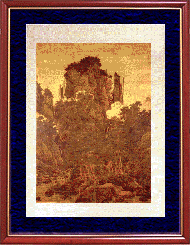
Li T'ang (ca. 1070-after 1150), Sung Dynasty
Original: Hanging scroll, ink and colors on silk, 188.7 x 139.8 cm
 |
 |
 |
 |
Li T'ang, a native of Ho-yang, served in the Hanlin Academy of Painting under Emperor Hui-tsung (1082-1135; r. 1101-1125) of the Northern Sung. Sometime between 1127 and 1130, after the fall of the Northern Sung in 1126, Li escaped to the south, where the government had established as the Southern Sung (1127-1279). There he re-entered the Painting Academy, which was set up during the period from 1131 and 1162. He went on to receive the title of Gentleman of Complete Loyalty and the prestigious Gold Belt. He also became a Painter-in-Attendance and one of the most dominant figures in Southern Sung court painting.
Li T'ang's signature appears on a pale spindly background peak to the left of the central mountain in this painting. It reads, ¡§Painted by Li T'ang of Ho-yang in spring of the chia-ch'en year [1124] of the Hsuan-ho Reign of the Great Sung.¡¨ Here, Li T'ang has portrayed the rugged, powerful features of a mountainous scene. Although the central mountain dominates the composition, as seen in other monumental landscape paintings of the Northern Sung, the foreground scene presents a more intimate setting that ultimately became common in the Southern Sung.
The rock faces and mountainsides look like wood chopped with an axe. These strokes later became known as ¡§axe-cut¡¨ texture strokes and often seen in Southern Sung court painting. This type of brushwork is ideal for suggesting the sharp features of rocky landscapes and eroded slopes. The puffs of white clouds in the middleground not only appear to move (adding a sense of movement to the scroll), but they also serve as backgrounds for highlighting the rocks and trees in front as well as for dividing the composition. Furthermore, the clouds provide a contrast for the jagged rocks, softening the work while opening up the composition. Distance is suggested by the large pines in the foreground compared to the background forests. A winding rocky path also adds depth and quietude to the composition. Cascades on either side of the central mountain fall from the heights, broken up by the rock forms and ending up as the rushing stream in the left foreground. The movement of the water stands out so vividly in this placid valley that it is almost audible--surely something that a master painter like Li T'ang had intended
¡@
